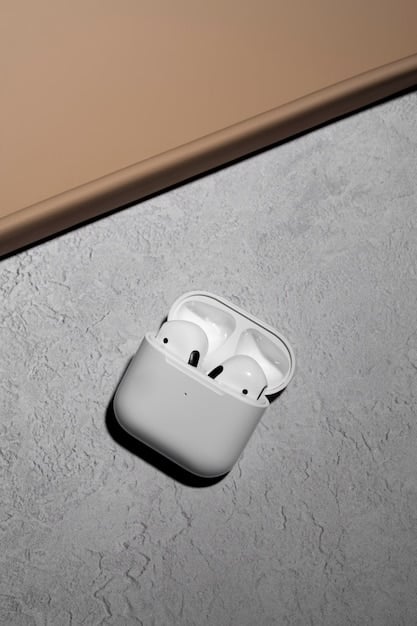The Rise of Spatial Audio: A Consumer Tech Guide

The Rise of Spatial Audio: A Consumer Tech Guide to Immersive Sound Experiences explores how spatial audio transforms sound perception, creating a more realistic and engaging listening environment in diverse applications like music, gaming, and movies.
Immerse yourself in the world of The Rise of Spatial Audio: A Consumer Tech Guide to Immersive Sound Experiences, a revolutionary technology transforming how we perceive and interact with sound.
What is Spatial Audio?
Spatial audio is an advanced audio technology designed to create a more immersive and realistic sound experience. Unlike traditional stereo or surround sound, spatial audio manipulates sound waves to mimic how we naturally hear sounds in the real world.
This technology isn’t just about listening; it’s about feeling the sound around you, just as you would in a real-world environment.
Key Differences from Traditional Audio
Traditional stereo audio creates a soundstage where sounds are positioned between two speakers, giving a left and right channel. Surround sound expands on this by adding more speakers around the listener, creating a more encompassing experience. However, spatial audio takes it a step further.
- Three-Dimensional Sound: Spatial audio adds height to the soundscape, creating a true 3D experience.
- Dynamic Head Tracking: Many spatial audio systems use head tracking technology to adjust the sound in real-time as you move your head, maintaining the realistic placement of sounds.
- Object-Based Audio: Unlike channel-based audio (like stereo or surround), spatial audio often uses object-based audio, where each sound source is treated as an independent object in a 3D space.
In essence, spatial audio enhances realism and immersion, making you feel more connected to the content you’re experiencing.
Spatial audio fundamentally alters how we consume media by moving beyond simple sound directionality to simulate a natural, three-dimensional auditory landscape.
How Spatial Audio Works
Spatial audio works by employing a combination of technologies to manipulate sound waves, emulating the way our ears and brain interpret sound in a natural environment. It’s not just about volume or direction; it’s about creating a complete auditory illusion.
To understand how this works, we need to look at the underlying technologies and techniques involved.

Key Technologies Behind Spatial Audio
Spatial audio relies on several sophisticated technologies to achieve its immersive effect.
- Head-Related Transfer Functions (HRTFs): HRTFs are mathematical functions that describe how the shape of our head, ears, and torso modify sounds as they travel from a source to our eardrums. Spatial audio systems use HRTFs to simulate these natural acoustic effects, creating the illusion that sounds are coming from specific locations in 3D space.
- Binaural Recording: This technique uses two microphones placed in a dummy head (or a real person’s ears) to capture sound as it would be naturally heard. When you listen to a binaural recording with headphones, you get a very realistic spatial experience.
- Object-Based Audio Coding: In object-based systems, each sound source is treated as an independent object with its own spatial coordinates. The system then renders the audio in real-time based on the listener’s position and orientation. Dolby Atmos and MPEG-H are examples of object-based audio formats.
Through these technologies, spatial audio systems are capable of delivering an unparalleled immersive audio experience. They replicate the natural way we perceive sounds, making virtual environments and recordings feel strikingly real.
By simulating how sound naturally interacts with our bodies and environment, spatial audio allows sound engineers to precisely position audio elements in a three-dimensional space, offering a level of realism unmatched by previous technologies.
Spatial Audio in Headphones
One of the most popular ways to experience spatial audio is through headphones. Many modern headphones and earbuds now support spatial audio technologies, offering an immersive listening experience on the go.
Spatial audio with headphones creates a personal and private listening environment where sounds appear to come from all around you.
Popular Headphones with Spatial Audio
Several headphones on the market feature built-in spatial audio capabilities.
- Apple AirPods (3rd generation), AirPods Pro, and AirPods Max: These headphones use Apple’s spatial audio technology with dynamic head tracking to create a theater-like experience.
- Sony WH-1000XM4 and WH-1000XM5: Sony’s headphones incorporate 360 Reality Audio, offering a spherical sound field.
- Bose QuietComfort 45 and Noise Cancelling Headphones 700: While not explicitly labelled as spatial audio, these headphones provide an immersive and wide soundstage.
When using spatial audio headphones, it is crucial that the content being listened to is compatible with the technology to fully appreciate the immersive effects that it provides.
Spatial audio headphones offer users an unmatched level of immersion, blending high-quality audio with sophisticated spatial positioning to turn everyday listening into an extraordinary experience.

Spatial Audio in Home Theaters
Spatial audio isn’t limited to headphones; it’s also making waves in home theater systems. With the right setup, you can transform your living room into a fully immersive cinematic experience.
Modern home theaters are leveraging spatial audio to create a truly lifelike soundscape, enveloping viewers in sound from all directions.
Setting Up a Spatial Audio Home Theater
To set up a spatial audio home theater, you’ll need a few key components:
- AV Receiver: An AV receiver that supports spatial audio formats like Dolby Atmos, DTS:X, or Auro-3D.
- Speakers: A speaker system configured for spatialaudio, including height speakers (ceiling-mounted or up-firing) to add the vertical dimension to the soundstage. A 5.1.2 or 7.1.4 setup is common.
- Content Source: A source device (Blu-ray player, streaming device) that can output spatial audio content.
Effectively implementing spatial audio in a home theater setting relies on strategic speaker placement and compatibility with leading audio formats.
A properly configured spatial audio home theater can place you right in the middle of the action, making movies, games, and music more engaging than ever before.
Spatial Audio in Gaming
For gamers, spatial audio offers a competitive edge and a more immersive gaming experience. The ability to accurately pinpoint the location of in-game sounds can significantly enhance gameplay.
Spatial audio provides gamers with a realistic soundscape that enhances their strategic capabilities and overall immersion.
Benefits of Spatial Audio for Gamers
Spatial audio provides several advantages for gamers:
- Enhanced Awareness: Hear footsteps, gunshots, and other environmental sounds with greater precision, allowing you to react faster to threats.
- Improved Immersion: Experience games as if you were truly in the virtual world, with sounds coming from accurate locations around you.
- Competitive Edge: Gain a tactical advantage by accurately locating opponents and understanding the game environment.
By delivering precise positional audio, spatial audio helps gamers to recognize critical audio cues, maximizing strategic decision-making and reaction times.
Whether playing competitively or exploring expansive open-world environments, spatial audio elevates the gaming experience to new heights, offering unparalleled realism and immersion.
The Future of Spatial Audio
The future of spatial audio looks promising, with ongoing advancements and wider adoption across various consumer tech applications. As technology evolves, spatial audio is set to become an integral part of our daily audio experiences.
Innovations in spatial audio technologies show great potential for fundamentally altering how we interact with and experience sound in immersive media.
Emerging Trends in Spatial Audio
Several trends are shaping the future of spatial audio:
- Integration with VR/AR: Spatial audio will become increasingly important for creating immersive virtual and augmented reality experiences, where realistic sound is crucial for presence.
- Personalized HRTFs: Customizing HRTFs based on individual ear and head shapes will improve the accuracy and realism of spatial audio experiences.
- Wider Content Availability: More music, movies, and games will be produced and distributed in spatial audio formats, making it more accessible to consumers.
The evolution of spatial audio promises a future where virtual soundscapes are indistinguishable from reality, enriching a plethora of applications from gaming to virtual tourism.
Spatial audio’s future is marked by greater personalization, increasingly sophisticated algorithms, and broader support from content creators and hardware manufacturers, promising a richer and more immersive auditory world for all.
| Key Aspect | Brief Description |
|---|---|
| 🎧 Immersive Sound | Creates a 3D audio experience that surrounds the listener. |
| 🎮 Gaming Advantage | Enhances awareness and provides a competitive edge in gaming scenarios. |
| 🎬 Home Theater | Transforms living rooms into immersive cinematic environments. |
| 🚀 Future Trends | Integration with VR/AR and personalized HRTFs will enhance realism. |
Frequently Asked Questions
▼
Spatial audio is a sound technology that creates an immersive, three-dimensional soundscape, making the listener feel sounds are coming from all around them, rather than just from left and right.
▼
Unlike surround sound, spatial audio adds height to the soundscape, using technologies like HRTFs to simulate how sound interacts with the head and ears in a natural environment.
▼
Many modern headphones support spatial audio, including Apple AirPods (3rd generation), AirPods Pro, AirPods Max, Sony WH-1000XM4, and Bose QuietComfort 45, among others.
▼
Yes, spatial audio is highly beneficial for gaming as it enhances awareness and immersion by accurately pinpointing the location of in-game sounds, providing a competitive edge.
▼
The future of spatial audio appears promising, with ongoing advancements expected in VR/AR integration, personalized HRTFs, and wider content availability, making it a standard part of audio experiences.
Conclusion
As spatial audio continues to evolve, it promises to redefine how we experience sound across various consumer tech applications, from headphones and home theaters to gaming and virtual reality, paving the way for increasingly immersive and realistic auditory environments.





